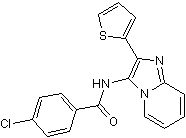GABA-A R delta Products
GABA A (γ-aminobutyric acid-type A) receptors are members of the cysteine-loop family of neurotransmitter-gated ion channels. GABA binding to A-type receptors induces anion-selective ion channel opening. These receptors are the principal fast inhibitory neurotransmitter receptors in the CNS. GABA A receptors are heteropentamer combinations of seven subunit types; α, β, γ, δ, ε, θ, and π. Three subunits, α, β, and γ, have at least three separate gene products in mammals, and typical GABA A receptors have some combination of α, β, and γ subunits.
In select neurons, however, a δ subunit replaces the γ subunit. It would appear that δ subunits have a preference for various α-β combinations. In cerebellar granule cells, the δsubunit contributes to a unique α6/β/δ heteromer. δ subunit receptors may function to limit the spread of excitatory impulses to dendritically-complexed neurons. They also appear to be sensitive to steroid modulation. The rat δ subunit is a 50 kDa, 433 amino acid (aa), 4 transmembrane protein with two terminal extracellular regions. The ligand-binding region is in the N-terminus (aa 4 - 246). The rat and mouse N-terminal extracellular domains (ECD) (aa 17 - 248) are 99% aa identical; the mouse and human ECD are 95% aa identical.
Products:
33 results for "GABA-A R delta" in Products
33 results for "GABA-A R delta" in Products
GABA-A R delta Products
GABA A (γ-aminobutyric acid-type A) receptors are members of the cysteine-loop family of neurotransmitter-gated ion channels. GABA binding to A-type receptors induces anion-selective ion channel opening. These receptors are the principal fast inhibitory neurotransmitter receptors in the CNS. GABA A receptors are heteropentamer combinations of seven subunit types; α, β, γ, δ, ε, θ, and π. Three subunits, α, β, and γ, have at least three separate gene products in mammals, and typical GABA A receptors have some combination of α, β, and γ subunits.
In select neurons, however, a δ subunit replaces the γ subunit. It would appear that δ subunits have a preference for various α-β combinations. In cerebellar granule cells, the δsubunit contributes to a unique α6/β/δ heteromer. δ subunit receptors may function to limit the spread of excitatory impulses to dendritically-complexed neurons. They also appear to be sensitive to steroid modulation. The rat δ subunit is a 50 kDa, 433 amino acid (aa), 4 transmembrane protein with two terminal extracellular regions. The ligand-binding region is in the N-terminus (aa 4 - 246). The rat and mouse N-terminal extracellular domains (ECD) (aa 17 - 248) are 99% aa identical; the mouse and human ECD are 95% aa identical.
Products:
| Reactivity: | Human, Mouse, Rat |
| Details: | Rabbit IgG Polyclonal |
| Applications: | IHC, WB, ICC/IF, IP, B/N, +1 More |
| Reactivity: | Human, Mouse, Rat |
| Details: | Mouse IgG2A Monoclonal Clone #N151/3 |
| Applications: | IHC, WB, ICC/IF, MA |
| Reactivity: | Human |
| Details: | Rabbit IgG Polyclonal |
| Applications: | IHC, WB |
| Reactivity: | Human, Mouse, Rat |
| Details: | Rabbit IgG Polyclonal |
| Applications: | WB |
| Applications: | AC |
Competitive and selective GABAA antagonist
| Alternate Names: | Gabazine |
| Chemical Name: | 6-Imino-3-(4-methoxyphenyl)-1(6H)-pyridazinebutanoic acid hydrobromide |
| Purity: | ≥98% (HPLC) |
Positive allosteric modulator of GABAA receptors
| Alternate Names: | 3a,5a-THPROG |
| Chemical Name: | (3α,5α)-3-Hydroxy-pregnan-20-one |
GABAA agonist
| Alternate Names: | Gaboxadol |
| Chemical Name: | 4,5,6,7-Tetrahydroisoxazolo[5,4-c]pyridin-3-ol hydrochloride |
| Purity: | ≥98% (HPLC) |
α5-selective GABAA inverse agonist
| Chemical Name: | 3-(1,1-Dimethylethyl)-7-(5-methyl-3-isoxazolyl)-2-[(1-methyl-1H-1,2,4-triazol-5-yl)methoxy]-pyrazolo[1,5-d][1,2,4]triazine |
| Purity: | ≥98% (HPLC) |
Positive allosteric modulator of GABAA receptors; displays subunit selectivity
| Chemical Name: | 4-Chloro-N-[2-(2-thienyl)imidazo[1,2-a]pyridin-3-yl]benzamide |
| Purity: | ≥97% (HPLC) |
GABAA partial agonist; displays subtype selectivity
| Chemical Name: | 3-(2,5-Difluorophenyl)-7-(1,1-dimethylethyl)-6-[(1-methyl-1H-1,2,4-triazol-5-yl)methoxy]-1,2,4-triazolo[4,3-b]pyridazine |
| Purity: | ≥98% (HPLC) |
Postitive allosteric modulator of GABAA receptors
| Chemical Name: | (3α,5β)-3-Hydroxy-pregnan-20-one |
Benzodiazepine antagonist
| Alternate Names: | Ro 15-1788 |
| Chemical Name: | 8-Fluoro-5,6-dihydro-5-methyl-6-oxo-4H-imidazo[1,5-a][1,4]benzodiazepine-3-carboxylic acid, ethyl ester |
| Purity: | ≥99% (HPLC) |
Benzodiazepine partial agonist
| Alternate Names: | Ro 16-6028 |
| Chemical Name: | (13aS)-8-Bromo-11,12,13,13a-tetrahydro-9-oxo-9H-imidazo[1,5-a]pyrrolo[2,1-c][1,4]benzodiazepine-1-carboxylic acid 1,1-dimethylethyl ester |
| Purity: | ≥98% (HPLC) |
Benzodiazepine inverse agonist
| Chemical Name: | N-Methyl-β-carboline-3-carboxamide |
| Purity: | ≥99% (HPLC) |
Active metabolite of oxcarbazepine (Cat. No. 3864)
| Alternate Names: | GP 47779 |
| Chemical Name: | 10,11-Dihydro-10-hydroxy-5H-dibenz(Z)[b,f]azepin-5-carboxamide |
| Purity: | ≥98% (HPLC) |
| Reactivity: | Human, Mouse, Rat |
| Details: | Mouse IgG2A Monoclonal Clone #N151/3 |
| Applications: | IHC, WB, ICC/IF |
| Reactivity: | Human, Mouse, Rat |
| Details: | Mouse IgG2A Monoclonal Clone #N151/3 |
| Applications: | IHC, WB, ICC/IF |
| Reactivity: | Human, Mouse, Rat |
| Details: | Mouse IgG2A Monoclonal Clone #N151/3 |
| Applications: | IHC, WB, ICC/IF |
| Reactivity: | Human, Mouse, Rat |
| Details: | Mouse IgG2A Monoclonal Clone #N151/3 |
| Applications: | IHC, WB, ICC/IF |
| Reactivity: | Human, Mouse, Rat |
| Details: | Mouse IgG2A Monoclonal Clone #N151/3 |
| Applications: | IHC, WB, ICC/IF |
| Reactivity: | Human, Mouse, Rat |
| Details: | Mouse IgG2A Monoclonal Clone #N151/3 |
| Applications: | IHC, WB, ICC/IF |
| Reactivity: | Human, Mouse, Rat |
| Details: | Mouse IgG2A Monoclonal Clone #N151/3 |
| Applications: | IHC, WB, ICC/IF |
| Reactivity: | Human, Mouse, Rat |
| Details: | Mouse IgG2A Monoclonal Clone #N151/3 |
| Applications: | IHC, WB, ICC/IF |

![Western Blot: GABA-A R delta Antibody [NB300-200] Western Blot: GABA-A R delta Antibody [NB300-200]](https://resources.bio-techne.com/images/products/GABA-A-R-delta-Antibody-Western-Blot-NB300-200-img0001.jpg)
![Western Blot: GABA-A R delta Antibody (N151/3) [NBP1-47616] Western Blot: GABA-A R delta Antibody (N151/3) [NBP1-47616]](https://resources.bio-techne.com/images/products/GABA-A-R-delta-Antibody-N151-3-Western-Blot-NBP1-47616-img0005.jpg)

![Immunohistochemistry-Paraffin: GABA-A R delta Antibody [NBP2-33421] Immunohistochemistry-Paraffin: GABA-A R delta Antibody [NBP2-33421]](https://resources.bio-techne.com/images/products/GABA-A-R-delta-Antibody-Immunohistochemistry-Paraffin-NBP2-33421-img0008.jpg)
![Western Blot: GABA-A R delta AntibodyAzide and BSA Free [NBP3-03679] Western Blot: GABA-A R delta AntibodyAzide and BSA Free [NBP3-03679]](https://resources.bio-techne.com/images/products/GABA-A-R-delta-Antibody-Western-Blot-NBP3-03679-img0001.jpg)












